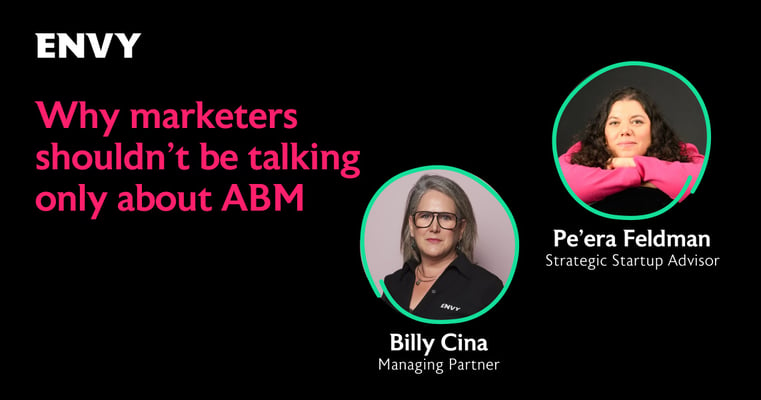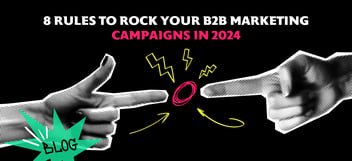
Here's why B2B marketers should quit the obsession with ABM
Envy’s been offering ABM strategies to our clients–because it works, some of the time, for some of our clients! But is ABM really the groundbreaking strategy it's made out to be, or is it just a sophisticated rebranding of targeting techniques we've used for decades?
If you ask Strategic Startup Advisor, Pe’era Feldman, ABM is nothing new and certainly isn’t the answer to all the B2B marketer’s dreams. We recorded our entire conversation, so if you prefer to listen, go here:
Demystifying Account-Based Marketing
First thing’s first, in essence, ABM is a focused growth strategy in which marketing and sales work together to target best-fit accounts and turn them into customers. Unlike traditional marketing, which casts a wide(r) net, ABM focuses on specific accounts, tailoring campaigns to address their unique challenges and needs.
But here's the catch—while the term ABM might sound new, the concept of targeted marketing is anything but new. Since the dawn of time, marketers have segmented audiences and crafted messages to target specific personas. Here’s what’s bothering Pe’era the most:
“I feel that every newsletter in the industry, every event in the industry is talking about why you should be implementing ABM, but ABM isn't even new news. Marketers have been targeting their personas for the past 20-30 years".
Why ABM is getting all the hype now
In our recent event organized by and for B2B marketing pros, Avishai Sharon, CEO of TrenDemon shared some B2B buyer journey benchmarks they’ve been looking at, and you’ll see they all make sense for ABM to grow in popularity:
- The number of known contacts within identified accounts is getting smaller, increasing buying group anonymity,
- Website conversion rates from Opportunities to Closed-won deals is increasing; so to achieve the same results, we need more accounts in the pipeline,
- B2B marketers are spending 120% more as opposed to 2023 for paid traffic to the website. The competition is dense, but our KPIs are not getting smaller.
The current ABM craze can be also attributed to these factors:
- The first is technology. With the rise of data analytics and intent-based marketing platforms, marketers now have tools that make ABM highly effective and a lot easier to manage.
- Secondly, the shift towards personalization in marketing aligns perfectly with ABM's core philosophy. ABM naturally resonates as a method that promises tailored experiences.
What can go wrong with ABM
Is ABM mistakenly viewed as a relatively quick fix? Yes. Does that lead to rushed campaigns that lack depth and precision? Also yes. This rush is mainly driven by pressure to deliver rapid results, pushing marketers to cut corners—shortening campaign durations, slashing budgets, and compromising on quality content. But for ABM to succeed, it needs:
- Time & patience - and we are talking months, as it is a long-term play targeting enterprise grade companies with loooong sales cycles,
- Budget - the technology to source the contacts and manage the process, paid media and content creation is not cheap, and you do need a solid tool like HubSpot to run ABM,
- People - teams from several departments working together in unison, including the C-level management,
- And a meticulous approach that respects the complexity of the process. You start cutting elements out of your process? ABM won’t work.
Think about the targeting, for instance. The key to successful ABM lies in precise segmentation and targeting. Sometimes it could be a named list of specific companies and specific titles, but essentially, when selling to enterprise grade companies, you don't have one decision maker, you probably have a buying committee of up to 20-25 people–they are champions, they are evangelists, they are people who understand their organization’s pain very well.
“ABM is just a fancy word probably invented by the tech providers for their intent based systems. If you're not segmenting your audience, and if you're not targeting a specific group with a specific message with a specific process of a specific budget, then your chances of succeeding are kind of mediocre, ABM or not".
Attracting and engaging with them involves understanding the nuances of their pain points to their decision-making processes. Rather than guessing, we should rely on data to inform our segmentation, use insights to map out the buying committee within each target account and tailor messaging to address their specific concerns and motivations. You need to have a product market fit, very clear messaging & value proposition.
No brand awareness? No ABM!
Brand awareness plays a critical role in the success of ABM campaigns. Without a recognizable brand, even the most well-crafted ABM campaign will struggle to make an impact. Think about the last time you engaged with a company you hadn’t heard of—chances are, their outreach didn’t catch your attention. For ABM to work, it must be part of a broader effort to build a strong, recognizable brand presence in the market.
“ABM, as a framework, as a methodology, is something that supports your sales and marketing initiatives, it doesn't create it from scratch".
And it’s not only about brand awareness. ABM takes time–so if you're not running additional campaigns in parallel, and if you haven't got additional tracks to bring in the leads, then management are going to get very, very frustrated with ABM. In order for ABM to actually work, you need to plan other activities for top of the funnel and middle of the funnel leads. Think about integrating ABM with other marketing strategies, such as demand generation and lead nurturing. By running parallel campaigns that target broader audiences, you can ensure a steady flow of leads at all stages of the funnel.
Is ABM worth the hype? The answer is both yes and no. While it offers significant advantages for B2B marketers, it’s not a one-size-fits-all solution. It must be viewed as part of a broader marketing strategy—one that values segmentation, brand awareness, and collaboration.
If your ICP is/has:
- An enterprise,
- A long sales process (months+)
- Multiple (identifiable) stakeholders/buying committee
- And the product carries a significant price tag ($10,000s+)
Then ABM could be a good strategy for you.
Start small, learn from your efforts, and gradually expand your initiatives. And if you find yourself needing help, we’ve been offering ABM as part of our services for more than 10 years now.






